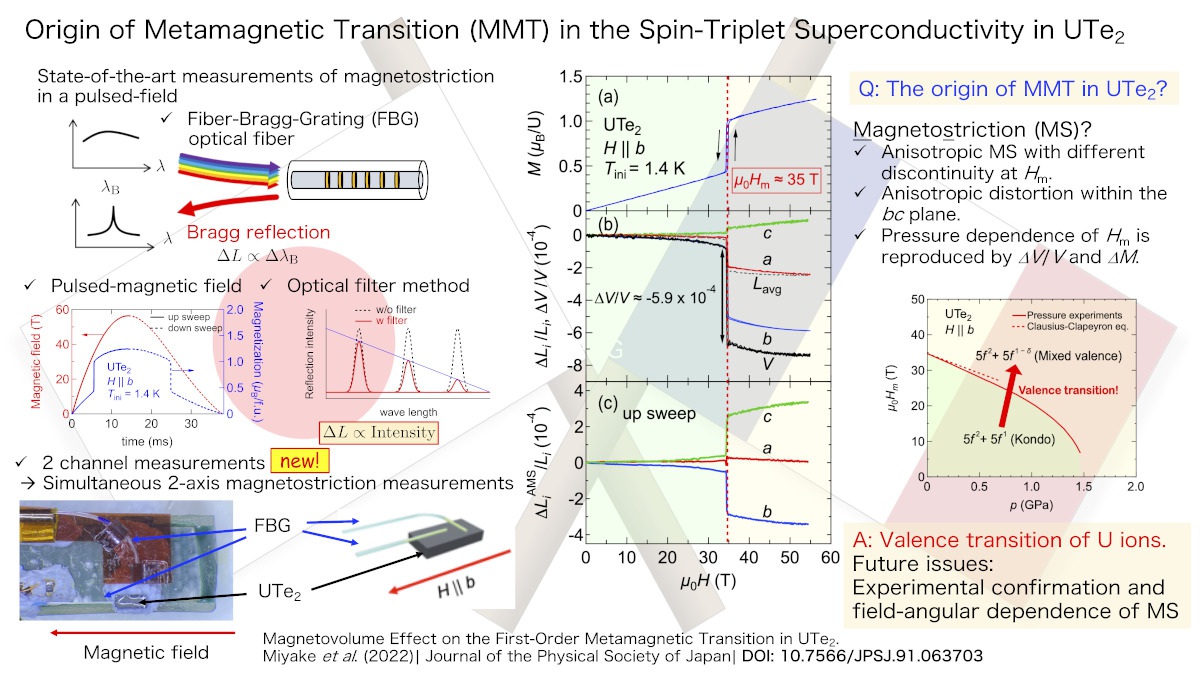Origin of Metamagnetic Transition (MMT) in the Spin-Triplet Superconductivity in UTe2
© The Physical Society of Japan
This article is on
Magnetovolume Effect on the First-Order Metamagnetic Transition in UTe2
(JPSJ Editors' Choice)
J. Phys. Soc. Jpn. 91, 063703 (2022).
State-of-the-art magnetostriction measurements in a pulsed-magnetic field reveal the origin of a metamagnetic transition of spin-triplet superconductor UTe2. We propose that the uranium valence fluctuation plays a crucial role in its metamagnetic and superconducting transitions.

The metamagnetism realized in heavy fermion systems has been well studied to date. At the metamagnetic transition/crossover fields, magnetization increases discontinuously/non-lineally, and fluctuations develop. Consequently, the effective mass increases. Thus, the metamagnetism may induce a new quantum state, such as a superconducting transition. The uranium-based ferromagnetic superconductors have been good playgrounds to study the relationship between metamagnetism and superconductivity. Quite recently, another related system, UTe2, was discovered.
The superconductivity in a paramagnetic heavy fermion system, UTe2, became a hot topic in condensed matter physics community since the realization of the spin-triplet state, which is expected for use in quantum computing. The external stimuli, such as pressure, magnetic field, and its applied direction, make UTe2 more attractive. The most remarkable feature is the magnetic-field-direction controlled superconductivity. For H || b axis, superconductivity is reinforced by increasing the fields but is killed at the metamagnetic field Hm ~ 35 T, where a first-order metamagnetic transition takes place. However, the field applied near the orthorhombic [011] direction induces another superconducting phase above Hm. Because experimental probes usable under such extreme conditions were limited, the role of metamagnetic transition in the appearance/disappearance of superconductivity is far from complete understanding. Moreover, the metamagnetism in UTe2 must be more clarified. These still remain a big challenge for experimentalists.
Magnetostriction, that is, the length/volume change with magnetic field, should offer hints at the aforementioned issues. The authors have developed magnetostriction measurements combining the fiber Bragg grating fiber optics and optical filter method that cover a wide range of ultra-high-magnetic fields beyond 100 T. A new attempt demonstrated in this article is simultaneous magnetostriction measurements up to 55 T. We obtained the linear magnetostriction along the two principal axes within a one-field scan; thus, we could perform measurements efficiently. This improvement also enables us to confirm the reliability and reproducibility of the magnetostriction measurements. Using a single crystal of UTe2, we revealed the magnetostrictions along all principal axes and the volume change at Hm.
Across Hm approaching from the lower fields, the volume shrinks discontinuously. This volume discontinuity well explains the pressure dependence of Hm and magnetic susceptibility reported earlier. Furthermore, we revealed that the metamagnetic transition in UTe2 involves anisotropic lattice deformation. Considering the localized and itinerant duality nature of uranium ions, we proposed that the uranium valence transition is the origin of metamagnetism. We also discussed the singular behavior in UTe2
by comparing it with the other heavy fermion systems. Our findings deepen the understanding of the fascinated physics realized in UTe2.
(The figure has been replaced as of July 19, 2022)
(Written by A. Miyake on behalf of all authors)
Magnetovolume Effect on the First-Order Metamagnetic Transition in UTe2
(JPSJ Editors' Choice)
J. Phys. Soc. Jpn. 91, 063703 (2022).
Share this topic
Fields
Related Articles
-
Variety of Mechanically Induced Spin Currents in Rashba Systems
Electronic transport in condensed matter
Magnetic properties in condensed matter
Structure and mechanical and thermal properties in condensed matter
2024-3-22
Various types of spin currents, including unconventional types, are generated in Rashba spin-orbit coupled systems by dynamic lattice distortions associated with, for example, surface acoustic waves.
-
Current Melt Frozen Electrons
Dielectric, optical, and other properties in condensed matter
Magnetic properties in condensed matter
2024-1-15
The origin of the current-induced insulator-to-metal transition of samarium monosulfide was explained by the 4f−5d hybridization observed using optical reflectivity and photoelectron spectroscopies.
-
Towards Uncovering the Hidden Order of URu2Si2 Phase Transition
Magnetic properties in condensed matter
Electronic structure and electrical properties of surfaces and nanostructures
2024-1-11
We propose a chiral charge as the hidden order parameter in URu2Si2 and present experiments to detect it by focusing on breakings of mirror and inversion symmetries at the local uranium ion.
-
Magnetic Excitation in S = 1/2 Antiferromagnetic Chain CsCoCl3 with Ising-Like Exchange Interaction
Magnetic properties in condensed matter
2023-11-13
The results of high-field electron spin resonance measurements in the millimeter-wave to terahertz region reveal unconventional magnetic excitation in S = 1/2 one-dimensional antiferromagnets.
-
Strange Elastic Anomalies with Ultraslow Dynamics around Magnetic Critical Endpoint
Structure and mechanical and thermal properties in condensed matter
Magnetic properties in condensed matter
2023-11-2
Near the magnetic critical endpoint of UCoAl, peculiar elastic anomalies exhibiting exotic ultraslow dynamics arising from electric quadrupoles are indicated. Combining this with diverse fluctuations, intriguing phenomena and exotic ground states are expected.
